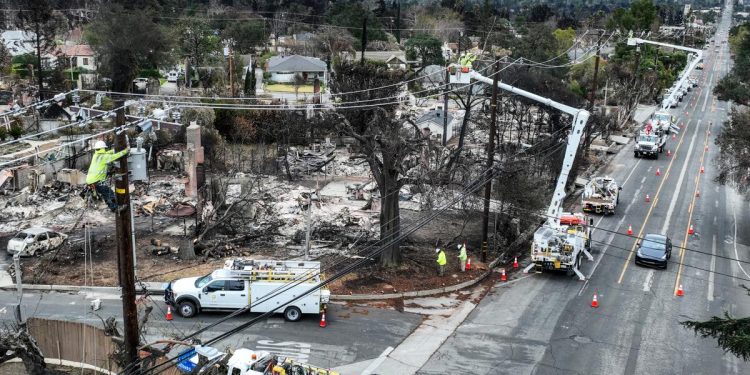In a continuous effort to accelerate reconstruction after the devastating fire storms of Los Angeles, Governor Gavin Newsom has suspended Californian environmental laws this week for public service providers working to reinstall a key infrastructure.
Its latest decree eliminates the requirements to comply with California Environmental Quality Act, commonly known as CEQA, and California Coastal Act for public services working to rebuild “electrical, gas, water, sewage and telecommunications infrastructures” in fire burns areas Palisades and Eaton.
Newsom has also continued to encourage the “basement” of utility equipment when possible, which, according to him, will help minimize the risk of future fire in these communities.
“We are determined to rebuild Altadena, Malibu and Pacific Palisades stronger and more resilient than before,” said Newsom in a statement. “Accelerate the pace that we rebuild our utility systems will help bring back the survivors more quickly and prevent future fires.”
This decision is based on the previous decrees of Newsom which exempted the work of reconstruction of houses and companies destroyed or damaged by fires as well as on efforts to prevent forest fires from the two environmental laws.
The CEQA requires that local and state agencies identify and reduce the environmental impacts of their work. California Coastal Act, which has made California Coastal Commission permanent, presents regulations for coastal development and protection.
Although the laws have been announced by environmentalists, their processes have long been considered to be expensive by promoters, and residents and managers have urged their needs to decrease or be canceled to accelerate fire recovery. The Trump administration has also challenged the California coastal commission – which generally regulates any coastal development as listed by state coastal law – and indicated that federal aid could have stipulations that target the work of the Commission.
“The key is now to make sure that we move quickly to meet the needs of underground not only traditional public services for electricity but also water and sewer pipes, and do so simultaneously,” said Newsom in a video published on social networks this week.
Joshua Smith, spokesperson for the coastal committee, refused to comment on the last decree.
Previously, the executive director of the Commission had specified that coastal development permits are generally removed after disasters such as Los Angeles fires, as long as the new construction is not greater than the destroyed structure it replaces. This declaration, however, has since been withdrawn from the Commission’s website.
In a letter sent last month, Newsom urged southern California Edison, the largest electricity supplier in the region, to do everything he can to rebuild lines underground in these areas.
“SCE has the possibility of strengthening a more modern, reliable and resilient electrical distribution system which can meet the immediate and future needs of the community,” wrote Newsom, adding that he had praised the information and suggestions that would facilitate these efforts and maintain costs.
The installation of public services underground is much more expensive than construction above typical soil, which has limited the practice.
David Eisenhauer, an Edison spokesperson, said that the CEQA derogation and the Coastal Act will help continuous efforts to rebuild and move underground lines.
“We appreciate the action of Governor Newsom to help accelerate permits,” said Eisenhauer. “This will help us continue this basement process and help communities to rebuild stronger.”
Eisenhauer said Socal Edison was already restoring and moving some of his electrical sons underground in the fires affected by fires. Some of this work had been planned – and authorized – beforehand, in particular by moving 40 miles of line underground in Altadena and doing the same with 80 miles in the Palisades region, he said. However, this decree will help to mitigate the authorization process for future work.
It was not immediately clear how other public services could benefit from the decree, if necessary. The representatives of Southern California Gas Co. and the Department of Water and Power of Los Angeles did not immediately respond to requests for comments.
Newsom previously said that its executive orders renouncing these environmental laws do not report a change in California’s support for such efforts, although many environmental activists fear that exemptions from large people can have serious consequences on the road.
Bruce Reznik, Executive Director of Los Angeles Waterkeeper, a non -profit organization that defends clean waterways, said that it understood the urgency of rebuilding, but that these efforts need a balance that considers important environmental protections – not derogations and exceptions.
“We all want to see the reconstruction occurring as quickly as possible … But we must also be intelligent on this subject,” said Reznik. “We must build the reality of the reality of climate change today.”
He said that the natural space in Altadena and Pacific Palisades was a large part of the reason why people liked to live there, and it is important to protect these areas – as CEQA and California Coastal Act do.
“These laws play a truly critical role by ensuring that we rebuild, we do so taking into account climate resilience, protecting from new natural disasters … (and) the health of our navigable and ecosystems,” he said. “Unfortunately, this was not and the governor worked, and you have to worry about what it will mean.”
Susan Jordan, executive director of California Coastal Protection Network, said that the continuous news of Newsom is based on the environmental practices it has seen in fires, including the decision not to test the soil in the affected areas.
“I hope that the governor will one day recognize that the coastal commission is a voluntary partner and one of the best tools he has in his toolbox to ensure a quick, enlightened and coordinated response to establish a long -term future resilience along the coast,” said Jordan in a statement.
California Daily Newspapers


